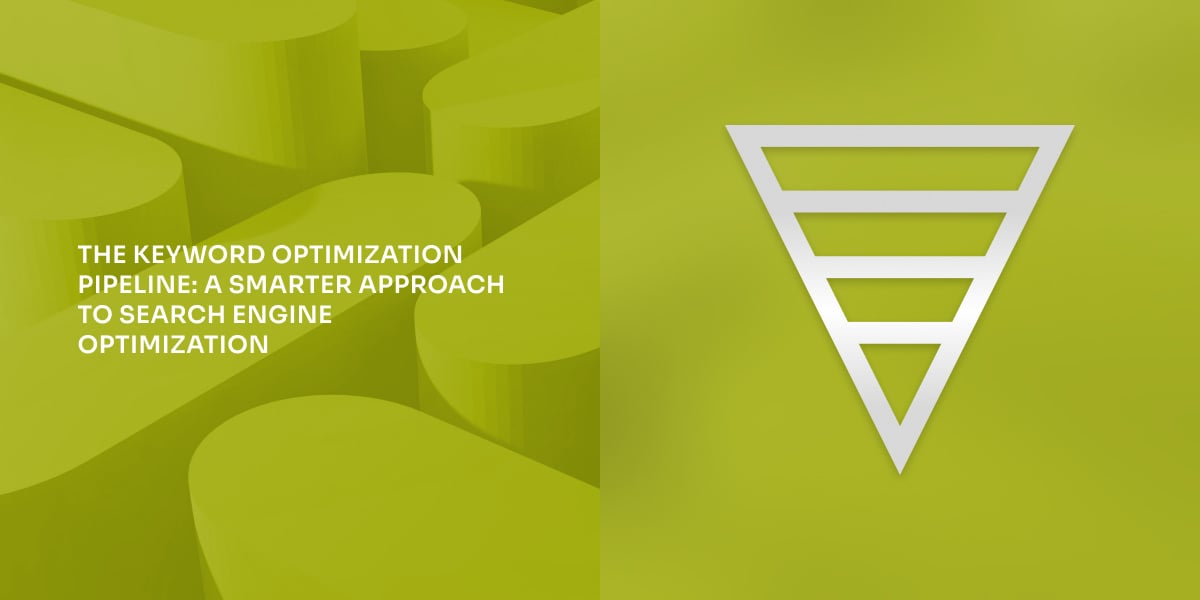The keyword optimization pipeline: a smarter approach to search engine optimization

A marketing strategist with a background in philosophy, Ara is the Coordinator for Marketing at WriteText.ai and 1902 Software. With seven years of experience in B2B marketing, she is deeply interested in AI and its impact on marketing and product development. As part of the core team at WriteText.ai, she helps bridge the gap between technology and strategy, making AI-powered solutions more accessible to businesses.

Everyone wants to rank for high-volume keywords, ones that thousands of users are searching for. But with that popularity comes fierce competition, and for newer or under-optimized websites, going after those keywords right from the start isn’t always the smartest move. Instead, SEO pros take a more strategic approach, focusing on gradual growth to build up rankings over time.
This approach, which we’ll call the "keyword optimization pipeline," begins by targeting low-difficulty keywords and gradually climbing toward more competitive terms as your site’s SEO authority grows. Soon, this process could get even simpler, thanks to emerging tools that streamline the entire pipeline through continuous optimization and intelligent content refresh.
What is keyword difficulty and how is it calculated?
Keyword difficulty measures how hard it is to rank for a specific keyword on search engine results pages (SERPs). It’s usually calculated based on several factors, including how competitive the keyword is, the number of high-authority websites already ranking for it, the strength of their SEO strategies, etc.
SEO tools typically provide a difficulty score from 1 to 100, with higher numbers indicating more competition. To improve ranking chances, targeting lower-difficulty keywords is a smart starting point, especially for newer websites.
Why starting with low-difficulty keywords matters
For websites just starting to focus on search engine optimization, aiming for high-difficulty keywords from the get-go can feel like trying to run a marathon before you’ve trained for it. Here’s why starting with low-difficulty keywords is the smarter route:
- Low-difficulty keywords have less competition, meaning it’s far more realistic for new or under-optimized sites to rank quickly.
- Even if these keywords don’t have massive search volumes, ranking for them helps drive that much-needed traffic to your site, giving you a visibility boost.
- As you start to rank for these terms, search engines take notice. Over time, your site builds domain authority, which strengthens its chances of ranking for tougher keywords down the line.
- After you gain traction, you can begin targeting higher-difficulty keywords, backed by the authority and trust your site has earned.
Ranking for high-difficulty, high-volume keywords right away is tough for new websites because well-established competitors dominate those terms. These sites have likely spent years refining their SEO, and search engines tend to favor them. By starting small, you give your site the chance to grow and establish trust at a sustainable pace.
Building your way up: The keyword optimization pipeline
Search engine optimization isn’t a one-time fix; it’s an ongoing journey that mirrors the growth of your site. That’s where the keyword optimization pipeline comes in—a method that lets you gradually scale up your keyword strategy as your SEO authority increases.
The process starts by targeting low-difficulty keywords, those with less competition but enough search volume to drive visibility. As your site begins ranking for these terms, search engines recognize your relevance, boosting your domain authority. From there, you iteratively optimize content to target more competitive keywords, gradually moving up the pipeline. This dynamic SEO approach—one that evolves with keyword trends and rankings—ensures your strategy continually progresses, building on a strong foundation as your authority grows.
How the keyword optimization pipeline works in practice
Implementing this technique takes planning and patience, but the results are worth it. Here’s how to put the keyword optimization pipeline into action:
- Do your keyword research.
Start by identifying low-difficulty keywords that are relevant to your business. Look for those sweet spots where there’s enough search volume, but not too much competition. SEO tools like Ahrefs, SERPStat, and Google Keyword Planner can help you find these gems. - Create targeted content.
Once you’ve got your keywords, write content that revolves around them. Whether it’s a blog, product page, or landing page, make sure it’s SEO-optimized but still valuable to your readers. - Track and refine.
After publishing, keep an eye on how your content performs. Tools like Google Analytics or Matomo can help you monitor rankings, traffic, and engagement. This is where the iterative nature of SEO comes in—optimization doesn’t end after one round. - Revise for higher-difficulty keywords.
Once your site starts ranking for the initial low-difficulty keywords, it's time to take the next step: targeting more competitive keywords.
Here’s how it works: As your site gains authority and credibility with search engines by ranking for easier keywords, you can begin optimizing that same content for higher-difficulty terms—those keywords with more competition but greater potential for traffic. This might involve tweaking the wording or integrating more specific and competitive keywords into headings, subheadings, and body text.
By doing this gradually, you leverage your existing rankings to start climbing for more competitive terms over time, all without needing to create entirely new content. - Repeat the process.
Refining and revising your content as your site grows is crucial. Why? Because SEO isn’t a one-and-done effort—it’s an ongoing process. As search algorithms evolve and competitors update their content, you need to ensure your site stays relevant and competitive.
Each time you refine your content—whether it’s adding new insights, improving keyword usage, or updating outdated information—you’re boosting your chances of ranking for those high-difficulty, high-volume keywords that once seemed unreachable (while still ranking for the old keywords).
Why it works: SEO fundamentals
The keyword optimization pipeline is grounded in SEO basics, and here’s why it works so well:
- Search engines like Google don’t trust new sites overnight. By working your way up through low-difficulty keywords, you allow your site to steadily build domain authority. As search engines notice your consistency and relevance, they reward you with higher rankings.
- Each page on your site can develop its own authority. By revisiting and optimizing pages for progressively more competitive terms, you leverage the page’s existing authority to rank for even more difficult keywords.
- This approach is a marathon, not a sprint. Instead of aiming for top-tier keywords right off the bat, the keyword optimization pipeline builds a solid foundation that strengthens over time, making it easier to rank for competitive keywords as your site matures.
In the end, this method creates a scalable search engine optimization strategy, allowing your site to grow and thrive without trying to do too much too soon.
Introducing automation into the process
There’s no denying that manual keyword optimization can be a time-consuming process. Constantly researching, rewriting, and refining takes effort, especially as your site grows and your SEO strategy becomes more complex.
But that’s where AI and automation are making a difference. Imagine having a tool that could handle everything—keyword research, content optimization, and even ongoing refinement—with minimal to no input from you.
Using ecommerce-specific AI, this kind of automation could guide your site through the keyword optimization pipeline, helping you stay competitive while reducing manual effort. From ranking for low-difficulty terms to gradually targeting more competitive keywords, this optimization pipeline helps your site grow strategically in search visibility.
With features like automatic metadata optimization, bulk content generation, and intelligent content refresh, WriteText.ai enables ongoing rewrites and updates—ensuring your content evolves with search trends and keeps your SEO strategy moving forward.
Manual optimization has its merits, but the future of search engine optimization might just lie in smarter tools that take over the heavy lifting.
WriteText.ai’s upcoming features in its next major version could be the key to making keyword optimization faster, smarter, and more efficient—letting you focus on other aspects of your business while your SEO runs on autopilot.
Conclusion
The keyword optimization pipeline is a proven strategy for building long-term SEO success. By starting small and optimizing for increasingly competitive terms, you set your site up for sustainable growth.
And as SEO evolves, so will the tools we use. With advancements like those from WriteText.ai, navigating the pipeline could soon become even easier, helping you optimize your pages seamlessly, with minimal manual effort and a more end-to-end content lifecycle.